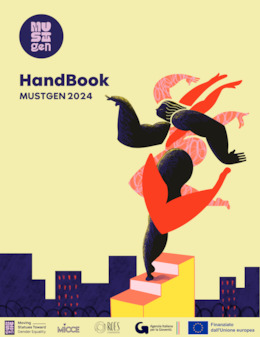Toolbox — For Training and Youth Work
All new tools in your inbox: Be the first to know about new tools for learning with our e-mail notifications.
Simulation Exercise, Exercise, Manual, Group Building Activity
‘Moving Statues Towards Gender Equality’ (MuST GEn), workshop methodology - Handbook
‘Moving Statues Towards Gender Equality’ (MuST GEn) promotes gender equality by raising awareness of stereotypes through artistic methods.
It offers a replicable model for youth workers, providing tools to challenge gender stereotypes and broaden impact.
Aims of the tool
MuST GEn aims to address these gender inequalities, focusing in particular on stereotypes linking sexism, violence against women and hegemonic masculinity.
Through this handbook, we aim to provide a practical and theoretical resource for all those who want to actively contribute to the construction of a more equitable and inclusive society, using art as a tool for reflection and change.
The specific objectives are three:
1 - Training of Youth Workers: Educating young people who work or aspire to work in educational, cultural and social contexts, with the aim of creating non-formal education paths on inclusivity and gender equality, starting from the observation of public statuary in cities.
2 - Enhancement of Art as an Educational Tool: Promoting art as a universal language capable of awakening interest and participation in the public life of the EU, using it as a tool for change and raising awareness on social issues among young people.
3 - Youth Involvement in GenderEquality Reflection: To encourage young people to actively participate in artistic-performance reflection on gender equality through an innovative non-formal education methodology.
Description of the tool
The MuST GEn (Moving Statues Towards Gender Equity) tool is an innovative educational programme that promotes gender equality through artistic reflection and critical engagement with public statues.
Designed for young people and youth workers, the tool addresses gender stereotypes, diversity and inclusion by promoting a deeper understanding of how public spaces reflect societal values, particularly in relation to gender.
The project uses the theme of statues - predominantly male and historically exclusionary - as a lens through which to examine gender inequalities in public representation and collective memory. Through workshops that combine critical thinking with creative expression, young participants are encouraged to rethink their relationship with public spaces and explore how art can serve as a catalyst for social change. This tool empowers young people to become active participants in promoting diversity, tolerance and equality through the arts.
Learning outcomes for young people:
1. Critical understanding of gender representation in public spaces: Participants will explore how public statues, which often reflect male-dominated narratives, shape collective memory and perceptions of gender, fostering a critical awareness of historical inequalities.
2. Reflecting on diversity and inclusion: Through engagement with public statues, participants will reflect on issues of diversity and inclusion and gain a better understanding of how marginalised groups, particularly women, are represented - or overlooked - in public spaces.
3. Artistic expression as a tool for advocacy: Young people learn to use artistic languages, such as performance and visual arts, to challenge gender stereotypes and advocate for social change in their communities.
3. Affirming the connection between public space and individual identity: Participants explore the personal and societal significance of shared public spaces and are encouraged to actively engage in reimagining these spaces as more inclusive and reflective of diverse identities.
4. Active citizenship and social responsibility: Workshops will encourage young people to take an active role in promoting gender equality and tolerance, empowering them to become advocates for a more inclusive society.
4. Practical tools for youth workers: Youth workers will be equipped with a methodology to guide young people in addressing gender issues through non-formal educational artistic activities, promoting a replicable model that can be adapted to different cultural and social contexts.
The tool is available in:
English, Italian and Greek.
The tool is also available in a pocket version or as a guideline only version, please do not hesitate to contact the MuST GEn team!
Disclaimer
SALTO cannot be held responsible for the inappropriate use of these training tools. Always adapt training tools to your aims, context, target group and to your own skills! These tools have been used in a variety of formats and situations. Please notify SALTO should you know about the origin of or copyright on this tool.
Tool overview

http://toolbox.salto-youth.net/4460
This tool is for
The MuST GEn project is designed primarily for: - Young People - Youth Workers and Educators - Artists and Creatives - Local communities
and addresses
Social Inclusion, Youth Initiatives, Gender issues, Youth Participation
It is recommended for use in:
Youth Exchanges
Training and Networking
Materials needed:
- Comfortable clothing
- A4 photographs of statues
- Speakers for music
- Post-its
- Markers
- Large cardboard
- Scissors
- Glue
- Magazines
- Notepads and pens
- Everyday objects (preferably clothing, like a t-shirt)
- Colored sheets
- Cardboard
- Photographic materials
- Music
Some materials may vary depending on the specific exercise or activity.
Duration:
The daily plan and the overall duration of the workshop can be adapted to the needs of your organisation. However, we recommend a minimum of 1 day for the icebreaker activity, 3 days for the trainings and 1 day for the final performance (preferably on consecutive days).
Most of the exercises are inspired by dance, dance theatre and physical theatre. The duration of each exercise can be between 30 minutes and 2 hours.
Behind the tool
The tool was created by
MICCE APS & ROES COOP
in the context of
Erasmus+ Small-scale partnerships in youth programme (KA210-YOU)
The tool has been experimented in
pilot workshop days
The tool was published to the Toolbox by
MUST GEN PROJECT (on 30 September 2024)
and last modified
25 September 2024
Comments
No comments have been posted yet.
If you want to comment on this tool, you need to be signed in with your MySALTO account. Sign in now